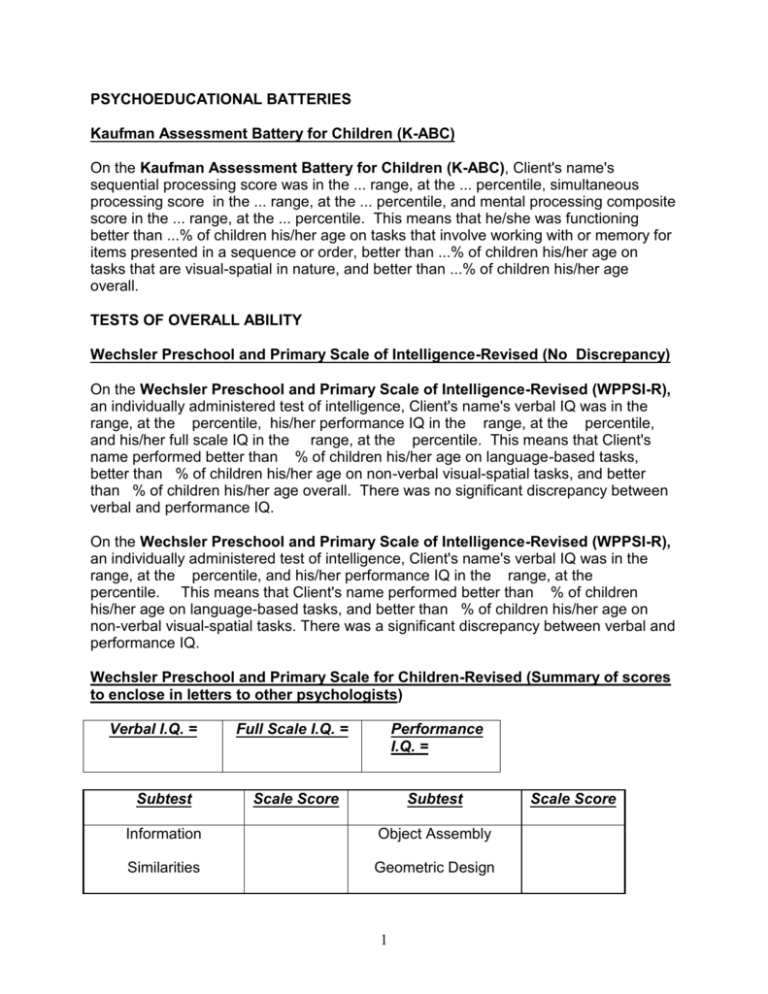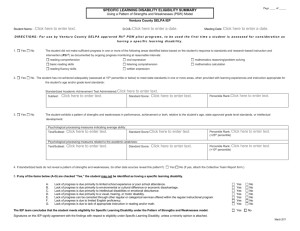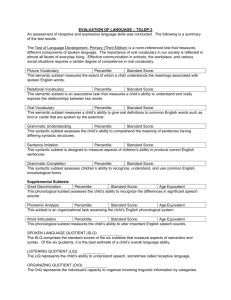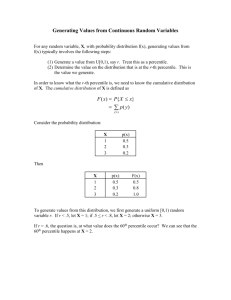Wechsler Intelligence Scale for Children-Revised (No
advertisement

PSYCHOEDUCATIONAL BATTERIES Kaufman Assessment Battery for Children (K-ABC) On the Kaufman Assessment Battery for Children (K-ABC), Client's name's sequential processing score was in the ... range, at the ... percentile, simultaneous processing score in the ... range, at the ... percentile, and mental processing composite score in the ... range, at the ... percentile. This means that he/she was functioning better than ...% of children his/her age on tasks that involve working with or memory for items presented in a sequence or order, better than ...% of children his/her age on tasks that are visual-spatial in nature, and better than ...% of children his/her age overall. TESTS OF OVERALL ABILITY Wechsler Preschool and Primary Scale of Intelligence-Revised (No Discrepancy) On the Wechsler Preschool and Primary Scale of Intelligence-Revised (WPPSI-R), an individually administered test of intelligence, Client's name's verbal IQ was in the range, at the percentile, his/her performance IQ in the range, at the percentile, and his/her full scale IQ in the range, at the percentile. This means that Client's name performed better than % of children his/her age on language-based tasks, better than % of children his/her age on non-verbal visual-spatial tasks, and better than % of children his/her age overall. There was no significant discrepancy between verbal and performance IQ. On the Wechsler Preschool and Primary Scale of Intelligence-Revised (WPPSI-R), an individually administered test of intelligence, Client's name's verbal IQ was in the range, at the percentile, and his/her performance IQ in the range, at the percentile. This means that Client's name performed better than % of children his/her age on language-based tasks, and better than % of children his/her age on non-verbal visual-spatial tasks. There was a significant discrepancy between verbal and performance IQ. Wechsler Preschool and Primary Scale for Children-Revised (Summary of scores to enclose in letters to other psychologists) Verbal I.Q. = Subtest Full Scale I.Q. = Performance I.Q. = Scale Score Subtest Information Object Assembly Similarities Geometric Design 1 Scale Score Arithmetic Block Design Vocabulary Mazes Comprehension Picture Completion Sentences (optional) Animal Pegs (optional) Wechsler Intelligence Scale for Children-Fourth Edition (WISC-IV) Client's name’s current level of intellectual functioning was evaluated using the Wechsler Intelligence Scale for Children-Fourth Edition (WISC-IV), an individually administered test of intelligence. This test provides a broad assessment of general intellectual functioning and school-related abilities. It measures four areas (i.e., Four Index Scores): verbal abilities, perceptual reasoning and organization, memory, and speed of processing information. There is also a Full Scale IQ score which assesses Clients name’s overall ability. On this test Client’s name was compared to other Canadian children his/her age. The results on this test and many of the other tests discussed below will be presented in terms of percentiles. Percentiles indicate where a child performs relative to others his or her age. For example, a score at the 65 th percentile indicates that the child did as well as or better than 65% of children his or her age. An average score is between the 25th and 75th percentiles. Client’s name’s Full Scale IQ was in the …range, at the ….percentile. In terms of the individual index scores, Client’s name obtained a score in the …range, at the …percentile on the Verbal Comprehension Index, which measures verbal concepts, vocabulary, general knowledge, and understanding of social rules. He/She obtained a score in the …range, at the …percentile on the Perceptual Reasoning Index which involves understanding of concepts presented in pictures, visual-spatial abilities and visual-motor integration. He/She obtained a score in the …range, at the …percentile on the Working Memory Index, which is comprised of tasks that require the ability to retain information in memory, manipulate it and produce a result. Finally, he/she obtained a score in the …range, at the …percentile on the Processing Speed Index, which measures speed and accuracy. [There was(were) a significant discrepancy(ies) between Verbal Comprehension/Perceptual Reasoning/Working Memory/Processing Speed and Verbal Comprehension/Perceptual Reasoning/Working Memory/Processing Speed.] Wechsler Intelligence Scale for Children-Fourth Edition (Summary of scores to enclose in letters to other psychologists) Full Scale IQ = Verbal Comprehension Working Memory Index Perceptual Reasoning 2 Processing Speed Index Index Similarities Vocabulary Comprehension Information (optional) Index Block Design Picture Concepts Matrix Reasoning Picture Completion (optional) Digit Span Letter-Number Sequencing Arithmetic (optional) Coding Symbol Search Cancellation (optional) Word Reasoning (optional) Wechsler Adult Intelligence Scale-Third Edition (No Discrepancy) On the Wechsler Adult Intelligence Scale-Third Edition (WAIS-3), an individually administered test of intelligence, Client's name's verbal IQ was in the range, at the percentile, his/her performance IQ in the range, at the percentile, and his/her full scale IQ in the range, at the percentile. This means that Client's name performed better than % of people his/her age on language-based tasks, better than % of people his/her age on non-verbal visual-spatial tasks, and better than % of people his/her age overall. There was no significant discrepancy between verbal and performance IQ. When Client's name's Index scores were considered, a more specific profile of strengths and problem areas were evident. He/She obtained a score in the …range, at the …percentile on the Verbal Comprehension Index, which means that he/she scored better than …% of people his/her age on tasks that measure verbal reasoning and expression. He/She obtained a score in the …range, at the …percentile on the Perceptual Organization Index which means that he/she scored better than …% of people his/her age on tasks that measure ability to interpret and organize visually presented material within a time limit. He/She obtained a score in the …range, at the …percentile on the Working Memory Index, which means that he/she scored better than …% of people his/her age on tasks that measure memory for material that was just presented, ability to sustain attention, concentrate, and exert mental control. He/She obtained a score in the …range, at the …percentile on the Processing Speed Index, which means that he/she scored better than …% of people his/her age on tasks that measure ability to process visually perceived nonverbal information quickly. Wechsler Adult Intelligence Scale-Third Edition (WAIS-3) (Discrepancy) On the Wechsler Adult Intelligence Scale-Third Edition (WAIS-3), an individually administered test of intelligence, Client's name's verbal IQ was in the range, at the percentile, and his/her performance IQ in the range, at the percentile. This means that Client's name performed better than % of people his/her age on language-based tasks, and better than % of people his/her age on non-verbal visual-spatial tasks. There was a significant discrepancy between verbal and performance IQ. 3 When Client's name's Index scores were considered, a more specific profile of strengths and problem areas were evident. He/She obtained a score in the …range, at the …percentile on the Verbal Comprehension Index, which means that he/she scored better than …% of people his/her age on tasks that measure verbal reasoning and expression. He/She obtained a score in the …range, at the …percentile on the Perceptual Organization Index which means that he/she scored better than …% of people his/her age on tasks that measure ability to interpret and organize visually presented material within a time limit. He/She obtained a score in the …range, at the …percentile on the Working Memory Index, which means that he/she scored better than …% of people his/her age on tasks that measure memory for material that was just presented, ability to sustain attention, concentrate, and exert mental control. He/She obtained a score in the …range, at the …percentile on the Processing Speed Index, which means that he/she scored better than …% of people his/her age on tasks that measure ability to process visually perceived nonverbal information quickly. Wechsler Adult Intelligence Scale-Third Edition (Summary of scores to enclose in letters to other psychologists) Verbal I.Q. = Full Scale I.Q. = Subtest Performance I.Q. = Scale Score Subtest Information Picture Completion Digit Span Picture Arrangement Vocabulary Block Design Arithmetic Object Assembly Comprehension Digit Symbol Similarities Matrix Reasoning Letter-Number Sequences Symbol Search Index Scores Verbal Comprehension Perceptual Organization Working Memory Processing Speed 4 Scale Score Stanford-Binet Intelligence Scale: Fourth Edition (SB:IV) On the Stanford-Binet Intelligence Scale: Fourth Edition (SB:IV), Client's name's verbal reasoning Standard Age Score (SAS) was in the ... range, at the ... percentile, abstract/visual reasoning SAS in the ... range, at the ... percentile, quantitative reasoning SAS in the ... range, at the ... percentile, and short-term memory SAS in the ... range, at the ... percentile. This means that he/she performed better than ...% of children his/her age on language based tasks, better than ...% of children his/her age on visual-spatial tasks, better than ...% of children his/her age on mathematical tasks, and better than ... % of children his/her age on tasks involving immediate recall for verbal and nonverbal material. Client's name's test composite was in the ... range, at the ... percentile. Thus, he/she was functioning better than ...% of children his/her age on the whole test. Leiter International Performance Scale-Revised The Leiter International Performance Scale-Revised (Leiter-R) was administered with the following results: Visualization and Reasoning Battery Composite Standard Score Percentile Brief IQ Screener Full Scale IQ Fluid Reasoning Fundamental Visualization Spatial Visualization Attention and Memory Battery Composite Standard Score Memory Screener Associative Memory Memory Span Attention Memory Process 5 Percentile Recognition Memory Detroit Tests of Learning Aptitude-4 (DTLA-4) The Detroit Tests of Learning Aptitude (DTLA-4) were administered with the following results: Verbal Subtest Standard Score Percentile Standard Score Percentile Word Opposites Sentence Imitation Story Construction Basic Information Word Sequences Nonverbal Subtest Design Sequences Reversed Letters Design reproduction Symbolic Relations Story Sequence Composite Standard Score Percentile General Mental Ability Linguistic Domain Verbal Nonverbal Attentional Domain Attention-Enhanced Attention-Reduced Motor Domain Motor-Enhanced Motor-Reduced Comprehensive Test of Nonverbal Intelligence (CTONI) 6 The Comprehensive Test of Nonverbal Intelligence (CTONI) was administered with the following results: Subtest Scores Pictorial Analogies Geometric Analogies Pictorial Categories Geometric Categories Pictorial Sequences Geometric Sequences Composite Standard Score Percentile Pictorial Nonverbal Intelligence (PNIQ) Geometric Nonverbal Intelligence (GNIQ) Nonverbal Intelligence (NIQ) Wechsler Abbreviated Scales of Intelligence (WASI) The Wechsler Abbreviated Scale of Intelligence (WASI) was administered with the following results: Verbal Scale IQ Performance Scale IQ Full Scale IQ (Block Design and Matrix Reasoning) Full Scale IQ (Vocabulary and Matrix Reasoning) Woodcock-Johnson III Tests of Cognitive Abilities The Woodcock-Johnson III Tests of Cognitive Abilities (WJ III COG) was administered with the following results: 7 Cluster Grade Score Percentile Comprehension-Knowledge Long-Term Retrieval Visual-Spatial Thinking Auditory Processing Fluid Reasoning Processing Speed Short-Term Memory General Intellectual Ability Note: The WJ III COG can only be scored by a computer software package. TESTS OF MEMORY Wide Range Assessment of Memory and Learning (WRAML) The Wide Range Assessment of Memory and Learning (WRAML) was administered with the following results: Subtest Scaled Score Picture Memory Design Memory Verbal Learning Story Memory Finger Windows Sound Symbol Sentence Memory Visual Learning Number/Letter Verbal learning Recall Story Memory Recall Sound Symbol Recall Visual Learning Recall Story Memory Recognition 8 Percentile Index Index Score Percentile Verbal Memory Visual Memory General Memory Learning The Children's Memory Scale (CMS)-ages 5-8 or 9-16 The Children's Memory Scale (CMS) was administered with the following results: Subtest Index Score Percentile Visual Immediate Visual Delayed Verbal Immediate Verbal Delayed Attention-Concentration Learning Delayed Recognition General Memory ACHIEVEMENT TESTS Wechsler Individual Achievement Test-Screener (WIAT-Screener) The Wechsler Individual Achievement Test-Screener (WIAT-Screener) was administered with the following results: Subtest Standard Score Percentile Basic Reading Mathematics Reasoning Spelling Kaufman Test of Educational Achievement Normative Update - Brief Form (K-TEA NU) The Kaufman Test of Educational Achievement Normative Update - Brief Form (KTEA NU) was administered with the following results: Subtest Standard Scores Percentile 9 Mathematics Reading Spelling Composite Wide Range Achievement Test-Third Edition (WRAT-3) The Wide Range Achievement Test-Third Edition (WRAT-3) was administered with the following results: Subtest Standard Score Percentile Reading Spelling Arithmetic Kaufman Test of Educational Achievement Normative Update - Comprehensive Form (K-TEANU) The Kaufman Test of Educational Achievement Normative Update Comprehensive Form (K-TEANU) was administered with the following results: Subtest Standard Score Percentile Reading Decoding Reading Comprehension Mathematics Applications Mathematics Computation Spelling Composite Scores Reading Mathematics Total Test Peabody Individual Achievement Test Revised (PIAT-R) 10 The Peabody Individual Achievement Test (PIAT-R) was given with the following results: Subtest Standard Score Percentile Mathematics Reading Recognition Reading Comprehension Spelling General Information Written Expression Composites Total Reading Total Test Wechsler Individual Achievement Test - Second Edition (WIAT-II) The Wechsler Individual Achievement Test - Second Edition (WIAT - II) was administered with the following results: Subtest Percentile Basic Reading Pseudoword Decoding Reading Comprehension Mathematics Reasoning Numerical Operations Listening Comprehension Oral Expression Spelling Written Expression 11 Age/Grage Equivalent Composites Reading Mathematics Language Writing Total Diagnostic Achievement Battery-Second Edition (DAB-2) The Diagnostic Achievement Battery-Second Edition (DAB-2) was administered with the following results: Subtest Grade Equivalent Percentile Story Comprehension Characteristics Synonyms Grammatic Completion Alphabet/Word knowledge Reading Comprehension Capitalization Punctuation Spelling Writing Composition Mathematics Reasoning Mathematics Calculation Composites Listening Speaking Reading Writing Mathematics Spoken Language Written Language Total Achievement Diagnostic Achievement Test For Adolescents-Second Edition (DATA-2) The Diagnostic Achievement Battery-Second (DATA-2) was administered with the following results: Subtest Standard Score 12 Percentile Receptive Vocabulary Receptive Grammar Expressive Grammar Expressive Vocabulary Word Identification Reading Comprehension Spelling Writing Composition Math Calculation Math Problem Solving Science Knowledge Social Studies Knowledge Reference Skills Composites Listening Speaking Reading Writing Mathematics Achievement Screener Total Achievement TESTS OF READING Woodcock Reading Mastery Tests-Revised The Woodcock Reading Mastery Tests - Revised, Form G/H were given with the following results: Subtest Grade Equivalent Visual Auditory Learning Letter Identification Word Identification Word Attack Word Comprehension Passage Comprehension 13 Percentile Clusters Readiness Cluster Basic Skills Cluster Reading Comprehension Cluster Total Reading-Full Scale Total Reading-Short Scale Durrell Analysis of Reading Difficulty-Third Edition On the Durrell Analysis of Reading Difficulty-Third Edition, Client's name was able to read orally at a grade ...level with regard to speed and accuracy. His/her comprehension at that level was good/fair/ poor. Oral reading problems included ... When asked to retell a story that he/she had read silently, Client's name could do so at a grade...level. Recall problems involved ... When asked questions about his/her recall of passages read orally to him/her, his/her comprehension was better/not better than when reading independently. Results of the word recognition and word analysis tests indicated that Client's name has mastered ... , but had difficulties with ... Diagnostic Reading Scales (DRS) On the Diagnostic Reading Scales (DRS), Client's name's Instructional Level, the level at which he/she could read orally with accuracy and adequate comprehension, was at a grade ... level. Oral reading errors included...He/she read ... His/her Independent Level, the level at which he/she could read silently with adequate comprehension, was at a grade ... level. Comprehension difficulties included ... Client's name's Potential Level, the level at which he/she could comprehend stories read aloud to him/her was at a grade ... level. Thus, his/her listening comprehension was better/not better than his/her reading comprehension when reading silently. Results of the word analysis and phonics tests indicated that Client's name has mastered ... , but had difficulties with ... Gray Oral Reading Test-Diagnostic (GORT-D) The Gray Oral Reading Test-Diagnostic (GORT-D) was administered with the following results: Subtest Standard Score Paragraph Reading Word Identification Morphemic Analysis Contextual Analysis Word Ordering 14 Percentile Decoding Word Attack Composites Meaning Cue Function Cue Graphic/Phonemic Analysis Total Reading Comprehensive Test of Phonological Processing (CTOPP) for ages 5 & 6 The Comprehensive Test of Phonological Processing (CTOPP) was administered with the following results: Subtest Standard Score Percentile Ellision (EL) Rapid Color Naming (RC) Blending Words (BW) Sound Matching (SM) Rapid Object Naming (RO) Memory for Digits (MD) Nonword Repetition (NR) Supplemental Blending Nonwords (BN) Composite Phonological Awareness Phonological Memory Rapid Naming Comprehensive Test of Phonological Processing (CTOPP) for ages 7 through 24 The Comprehensive Test of Phonological Processing (CTOPP) was administered with the following results: Subtest Standard Score Ellision (EL) Blending Words (BW) 15 Percentile Memory for Digits (MD) Rapid Digit Naming (RD) Nonword Repetition (NR) Rapid Letter Naming (RL) Supplemental Rapid Color Naming (RC) Phoneme Reversal (PR) Rapid Object Naming (RO) Blending Nonwords (BN) Segmenting Words (SW) Segmenting Nonwords (SN) Composites Phonological Awareness Phonological Memory Rapid Naming Alternate Phonological Awareness Alternate Rapid Naming TESTS OF RECEPTIVE AND EXPRESSIVE LANGUAGE Test of Early Language Development-Third Edition (TELD-3) The Test of Early Language Development -Third Edition (TELD-3) was administered with the following results: Quotient Standard Score Percentile Receptive Language Expressive Language Spoken Language Test of Adolescent and Adult Language-Third Edition (TOAL-3) The Test of Adolescent and Adult Language-Third Edition (TOAL-3) was administered with the following results; Subtest Standard Score Listening Vocabulary (LV) Listening/Grammar (LG) 16 Percentile Speaking Vocabulary (SV) Speaking/Grammar (SG) Reading/Vocabulary (RV) Reading Grammar (RG) Writing/Vocabulary (WV) Writing/Grammar (WG) Test of Language Development Primary- Third Edition (TOLD-P:3) The Test of Language Development Primary-Third Edition (TOLD:P3) was administered with the following results: Subtest Standard Score Percentile Picture Vocabulary Relational Vocabulary Oral Vocabulary Grammatic Understanding Sentence Imitation Grammatic Completion Word Discrimination-Optional Word Articulation-Optional Phonemic Analysis-Optional Composites Quotient Spoken Language Listening Speaking Semantics Syntax Organizing Test of Language Development Intermediate-Third Edition (TOLD I:3) The Test of Language Development Intermediate-Third Edition (TOLD I:3) was administered with the following results: Subtest Standard Score Sentence Combining Vocabulary Word Ordering Generals 17 Percentile Grammatical Comprehension Malapropisms Composites Quotient General Intelligence-Aptitude Spoken Language Listening Speaking Semantics Syntax Clinical Evaluation of Language Fundamentals - Third Edition (CELF-3) (age 6.021.11) The Clinical Evaluation of Language Fundamentals - Third Edition (CELF-3) was given with the following results: Subtest Standard Score Concepts and Directions Word Classes Word Associations Sentence Structure Word Structure Listening to Paragraphs Semantic Relationships Sentence Assembly Formulated Sentences Recalling Sentences Rapid Automatized Naming (RAN) Composites Receptive Language Score Expressive Language Score Total Language Score 18 Percentile TESTS OF WRITTEN LANGUAGE Test of Written Language-Third Edition (TOWL-3) The Test of Written Language-Third Edition (TOWL-3) was administered with the following results: Subtest Standard Score Percentile Vocabulary Spelling Style Logical Sentences Sentence Combining Thematic Maturity Contextual Vocabulary Syntactic Maturity Contextual Spelling Contextual Style Composites Quotient Contrived Writing Spontaneous Writing Overall Written Language Test of Written Spelling-Third Edition (TWS-3) The Test of Written Spelling-Third Edition (TWS-3) was administered with the following results: Subtest Standard Score Percentile Predictable Words Unpredictable Words Total Words TESTS OF MATHEMATICS KeyMath-Revised: A Diagnostic Assessment of Essential Mathematics Client's name's overall score on the KeyMath-R, a diagnostic mathematics test was approximately at the grade level. (The score is approximate because a subtest comprised of imperial measurement items had to be omitted because Canadian 19 children now learn metric measurement.) Client's name was relatively good on Subtest assessing... He/she could do items requiring... Problems were observed on Subtest assessing... He/she could do items involving... but had difficulty with... Client's name's performance on the KeyMath was higher than his/her performance in school as reported by his/her teacher and on the Test. This may be because the KeyMath has bright pictures, and with the exception of the computation section is given orally. Test of Mathematical Abilities-Second Edition (TOMA-2) The Test of Mathematical Abilities (TOMA-2) was administered with the following results: Subtest Standard Score Percentile Vocabulary (VO) Computation (CO) General Information (GI) Story Problems (SP) Attitude Toward Math (AT) MATH QUOTIENT TESTS OF ADAPTIVE SKILLS Vineland Adaptive Behaviour Scales The Vineland Adaptive Behaviour Scales were administered with the following results: Domain Standard Score Communication Domain Daily Living Skills Domain Socialization Domain Motor Skills Domain Composite Adaptive Behaviour Composite 20 Percentile







